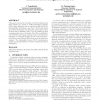Free Online Productivity Tools
i2Speak
i2Symbol
i2OCR
iTex2Img
iWeb2Print
iWeb2Shot
i2Type
iPdf2Split
iPdf2Merge
i2Bopomofo
i2Arabic
i2Style
i2Image
i2PDF
iLatex2Rtf
Sci2ools
VALUETOOLS
2006
ACM
2006
ACM
Using UML state machines and petri nets for the quantitative investigation of ETCS
This paper proposes the modeling of technical systems and their behavior by means of Unified Modeling Language (UML) State Machines and the extending UML Profile for Schedulability, Performance, and Time. This Profile allows the detailed description of quantitative system aspects such as times and probabilistic choice. For the resulting models a transformation into a Stochastic Petri Net is established. The Petri Net’s performance measures can be determined by simulation or numerical analysis. A part of the future European Train Control System (ETCS) serves as an application example. The relationship between ETCS communication quality and minimal distance between subsequent trains is investigated. Keywords UML State Machines, Stochastic Petri Nets, ETCS, Model Transformation
| Added | 14 Jun 2010 |
| Updated | 14 Jun 2010 |
| Type | Conference |
| Year | 2006 |
| Where | VALUETOOLS |
| Authors | Jan Trowitzsch, Armin Zimmermann |
Comments (0)

